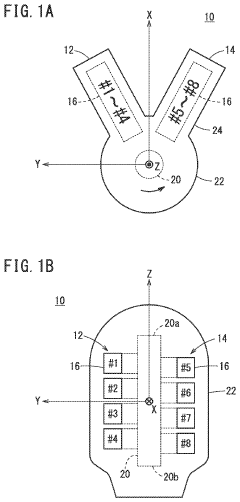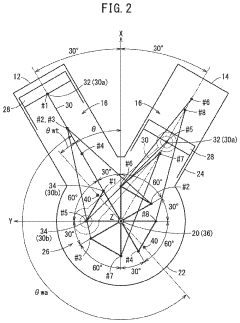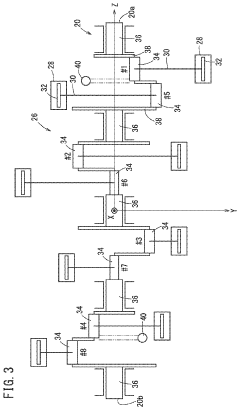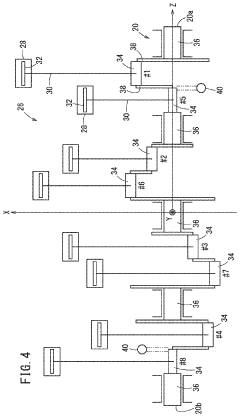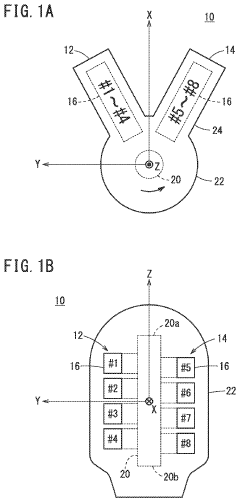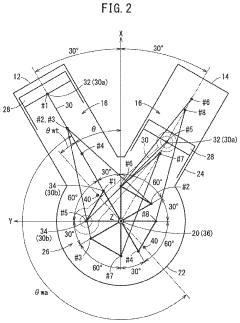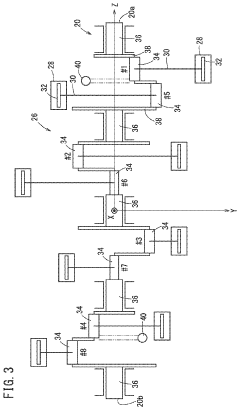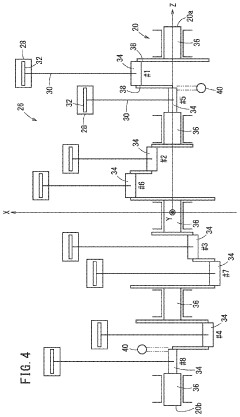The Role of V8 Engines in Luxury Cars
JUL 4, 20259 MIN READ
Generate Your Research Report Instantly with AI Agent
Patsnap Eureka helps you evaluate technical feasibility & market potential.
V8 Engine Evolution
The V8 engine has undergone significant evolution since its inception in the early 20th century. Initially developed for high-performance applications, V8 engines have become synonymous with luxury and power in the automotive industry. The timeline of V8 engine development can be traced through several key stages, each marked by technological advancements and engineering innovations.
In the 1930s and 1940s, V8 engines gained popularity in American luxury cars, setting the stage for their long-standing association with premium vehicles. The post-war era saw rapid advancements in V8 technology, with increased displacement and power output becoming hallmarks of luxury automobiles.
The 1960s and 1970s marked a golden age for V8 engines in luxury cars, with manufacturers competing to produce ever more powerful and refined powerplants. This period saw the introduction of high-compression ratios, improved fuel delivery systems, and more sophisticated valve train designs, all contributing to enhanced performance and smoothness.
The oil crises of the 1970s prompted a shift towards efficiency, leading to the development of smaller, more fuel-efficient V8 engines. This era saw the introduction of electronic fuel injection and engine management systems, which improved both performance and economy.
The 1990s and early 2000s witnessed a resurgence of V8 power in luxury vehicles, with advancements in materials science and computer-aided design allowing for lighter, more compact engines with improved power-to-weight ratios. Variable valve timing and multi-valve cylinder heads became common features, further enhancing efficiency and performance.
In recent years, the focus has shifted towards combining power with environmental responsibility. Modern V8 engines in luxury cars often incorporate technologies such as direct fuel injection, turbocharging, and cylinder deactivation. These innovations allow for impressive power outputs while meeting increasingly stringent emissions regulations.
The latest evolution in V8 engine technology for luxury cars involves hybridization. Many high-end manufacturers are now pairing V8 engines with electric motors, creating powerful yet efficient powertrains that offer the best of both worlds – the visceral thrill of a V8 with the eco-friendliness of electric propulsion.
Looking ahead, the future of V8 engines in luxury cars is likely to involve further refinement of hybrid technologies, as well as exploration into alternative fuels and advanced materials to maintain performance while reducing environmental impact. The V8 engine's journey in luxury cars continues to be a testament to engineering ingenuity and the enduring appeal of high-performance motoring.
In the 1930s and 1940s, V8 engines gained popularity in American luxury cars, setting the stage for their long-standing association with premium vehicles. The post-war era saw rapid advancements in V8 technology, with increased displacement and power output becoming hallmarks of luxury automobiles.
The 1960s and 1970s marked a golden age for V8 engines in luxury cars, with manufacturers competing to produce ever more powerful and refined powerplants. This period saw the introduction of high-compression ratios, improved fuel delivery systems, and more sophisticated valve train designs, all contributing to enhanced performance and smoothness.
The oil crises of the 1970s prompted a shift towards efficiency, leading to the development of smaller, more fuel-efficient V8 engines. This era saw the introduction of electronic fuel injection and engine management systems, which improved both performance and economy.
The 1990s and early 2000s witnessed a resurgence of V8 power in luxury vehicles, with advancements in materials science and computer-aided design allowing for lighter, more compact engines with improved power-to-weight ratios. Variable valve timing and multi-valve cylinder heads became common features, further enhancing efficiency and performance.
In recent years, the focus has shifted towards combining power with environmental responsibility. Modern V8 engines in luxury cars often incorporate technologies such as direct fuel injection, turbocharging, and cylinder deactivation. These innovations allow for impressive power outputs while meeting increasingly stringent emissions regulations.
The latest evolution in V8 engine technology for luxury cars involves hybridization. Many high-end manufacturers are now pairing V8 engines with electric motors, creating powerful yet efficient powertrains that offer the best of both worlds – the visceral thrill of a V8 with the eco-friendliness of electric propulsion.
Looking ahead, the future of V8 engines in luxury cars is likely to involve further refinement of hybrid technologies, as well as exploration into alternative fuels and advanced materials to maintain performance while reducing environmental impact. The V8 engine's journey in luxury cars continues to be a testament to engineering ingenuity and the enduring appeal of high-performance motoring.
Luxury Car Market
The luxury car market has experienced significant growth and transformation in recent years, driven by increasing global wealth, changing consumer preferences, and technological advancements. This segment of the automotive industry caters to high-net-worth individuals and enthusiasts who seek premium vehicles that offer superior performance, comfort, and prestige.
Luxury car sales have shown resilience even during economic downturns, with the market expanding in key regions such as China, North America, and Europe. The demand for luxury vehicles is particularly strong in emerging markets, where a growing middle class and rising disposable incomes fuel aspirations for premium automobiles.
Within the luxury car market, there is a notable trend towards SUVs and crossovers, which have gained popularity among affluent consumers seeking versatility and status. This shift has prompted many traditional luxury sedan manufacturers to expand their product lines to include high-end SUV offerings.
Performance remains a crucial factor in the luxury car segment, with many buyers placing a high value on powerful engines and advanced drivetrain technologies. V8 engines, in particular, continue to play a significant role in this market, offering the blend of power, smoothness, and prestige that luxury car buyers often demand.
Environmental concerns and stricter emissions regulations have led to increased focus on electrification and hybrid technologies in the luxury car market. Many manufacturers are investing heavily in developing electric and hybrid powertrains to complement their traditional combustion engine offerings, including V8s.
Brand heritage and exclusivity are key drivers in the luxury car market, with established marques like Mercedes-Benz, BMW, Audi, and Lexus dominating sales. However, there is also a growing niche for ultra-luxury and bespoke vehicles from brands such as Rolls-Royce, Bentley, and Aston Martin, where V8 engines often feature prominently.
The luxury car market is characterized by intense competition and rapid innovation. Manufacturers constantly strive to differentiate their offerings through cutting-edge technologies, superior craftsmanship, and personalization options. This has led to the integration of advanced driver assistance systems, connectivity features, and luxurious interior appointments that go beyond mere transportation to offer a complete luxury experience.
Luxury car sales have shown resilience even during economic downturns, with the market expanding in key regions such as China, North America, and Europe. The demand for luxury vehicles is particularly strong in emerging markets, where a growing middle class and rising disposable incomes fuel aspirations for premium automobiles.
Within the luxury car market, there is a notable trend towards SUVs and crossovers, which have gained popularity among affluent consumers seeking versatility and status. This shift has prompted many traditional luxury sedan manufacturers to expand their product lines to include high-end SUV offerings.
Performance remains a crucial factor in the luxury car segment, with many buyers placing a high value on powerful engines and advanced drivetrain technologies. V8 engines, in particular, continue to play a significant role in this market, offering the blend of power, smoothness, and prestige that luxury car buyers often demand.
Environmental concerns and stricter emissions regulations have led to increased focus on electrification and hybrid technologies in the luxury car market. Many manufacturers are investing heavily in developing electric and hybrid powertrains to complement their traditional combustion engine offerings, including V8s.
Brand heritage and exclusivity are key drivers in the luxury car market, with established marques like Mercedes-Benz, BMW, Audi, and Lexus dominating sales. However, there is also a growing niche for ultra-luxury and bespoke vehicles from brands such as Rolls-Royce, Bentley, and Aston Martin, where V8 engines often feature prominently.
The luxury car market is characterized by intense competition and rapid innovation. Manufacturers constantly strive to differentiate their offerings through cutting-edge technologies, superior craftsmanship, and personalization options. This has led to the integration of advanced driver assistance systems, connectivity features, and luxurious interior appointments that go beyond mere transportation to offer a complete luxury experience.
V8 Performance Challenges
V8 engines have long been synonymous with luxury and performance in high-end automobiles. However, as the automotive industry evolves, these powerful engines face several challenges that manufacturers must address to maintain their relevance and appeal in the luxury car market.
One of the primary challenges for V8 engines is meeting increasingly stringent emissions regulations. As governments worldwide implement stricter environmental policies, luxury car manufacturers must find ways to reduce the carbon footprint of their V8 engines without compromising performance. This has led to the development of advanced technologies such as cylinder deactivation, direct injection, and variable valve timing to improve fuel efficiency and reduce emissions.
Another significant challenge is the growing competition from alternative powertrains, particularly electric and hybrid systems. As electric vehicles continue to gain market share and improve their performance capabilities, V8 engines must justify their existence in terms of both power delivery and overall driving experience. This has prompted manufacturers to focus on enhancing the unique characteristics of V8 engines, such as their distinctive sound and linear power delivery, to maintain their appeal to luxury car enthusiasts.
The weight of V8 engines presents another hurdle for luxury car designers. As vehicle weight directly impacts fuel efficiency and handling, manufacturers are under pressure to reduce the overall mass of their vehicles. This has led to the exploration of lightweight materials and compact designs for V8 engines, as well as the integration of weight-saving technologies throughout the vehicle.
Balancing performance with comfort and refinement poses yet another challenge for V8-powered luxury cars. While these engines are capable of delivering exhilarating performance, luxury car buyers also expect a smooth and quiet ride. Engineers must develop sophisticated engine mounts, sound insulation, and vibration damping systems to ensure that the power of the V8 does not compromise the luxurious feel of the vehicle.
The cost of developing and producing V8 engines in compliance with modern standards is also a significant concern. As regulations become more stringent and technology more advanced, the investment required to keep V8 engines competitive continues to rise. This puts pressure on manufacturers to justify the inclusion of V8 engines in their lineup and may lead to reduced availability in some market segments.
Lastly, the challenge of brand perception and market positioning cannot be overlooked. While V8 engines have traditionally been associated with prestige and performance, changing consumer attitudes towards environmental responsibility and sustainability may impact their desirability. Luxury car brands must carefully navigate this shift in perception, potentially repositioning V8 engines as a premium option for select models rather than a standard feature across their range.
One of the primary challenges for V8 engines is meeting increasingly stringent emissions regulations. As governments worldwide implement stricter environmental policies, luxury car manufacturers must find ways to reduce the carbon footprint of their V8 engines without compromising performance. This has led to the development of advanced technologies such as cylinder deactivation, direct injection, and variable valve timing to improve fuel efficiency and reduce emissions.
Another significant challenge is the growing competition from alternative powertrains, particularly electric and hybrid systems. As electric vehicles continue to gain market share and improve their performance capabilities, V8 engines must justify their existence in terms of both power delivery and overall driving experience. This has prompted manufacturers to focus on enhancing the unique characteristics of V8 engines, such as their distinctive sound and linear power delivery, to maintain their appeal to luxury car enthusiasts.
The weight of V8 engines presents another hurdle for luxury car designers. As vehicle weight directly impacts fuel efficiency and handling, manufacturers are under pressure to reduce the overall mass of their vehicles. This has led to the exploration of lightweight materials and compact designs for V8 engines, as well as the integration of weight-saving technologies throughout the vehicle.
Balancing performance with comfort and refinement poses yet another challenge for V8-powered luxury cars. While these engines are capable of delivering exhilarating performance, luxury car buyers also expect a smooth and quiet ride. Engineers must develop sophisticated engine mounts, sound insulation, and vibration damping systems to ensure that the power of the V8 does not compromise the luxurious feel of the vehicle.
The cost of developing and producing V8 engines in compliance with modern standards is also a significant concern. As regulations become more stringent and technology more advanced, the investment required to keep V8 engines competitive continues to rise. This puts pressure on manufacturers to justify the inclusion of V8 engines in their lineup and may lead to reduced availability in some market segments.
Lastly, the challenge of brand perception and market positioning cannot be overlooked. While V8 engines have traditionally been associated with prestige and performance, changing consumer attitudes towards environmental responsibility and sustainability may impact their desirability. Luxury car brands must carefully navigate this shift in perception, potentially repositioning V8 engines as a premium option for select models rather than a standard feature across their range.
Current V8 Configurations
01 V8 Engine Design and Configuration
V8 engines are designed with eight cylinders arranged in two banks of four, forming a V-shape. This configuration allows for a compact design, improved power output, and balanced operation. Various aspects of V8 engine design, including cylinder arrangement, crankshaft configuration, and valve timing, are optimized to enhance performance and efficiency.- V8 Engine Design and Configuration: V8 engines are designed with eight cylinders arranged in two banks of four, forming a V-shape. This configuration allows for a compact design while providing high power output. The design often includes features for improved performance, fuel efficiency, and reduced emissions.
- Fuel Injection Systems for V8 Engines: Advanced fuel injection systems are developed for V8 engines to optimize fuel delivery and combustion. These systems may include direct injection, multi-port injection, or a combination of both, aiming to improve engine efficiency and reduce fuel consumption while maintaining high performance.
- Valve Train and Camshaft Innovations: Innovations in valve train and camshaft designs for V8 engines focus on improving engine breathing and overall efficiency. This may include variable valve timing, cylinder deactivation systems, and advanced camshaft profiles to enhance performance across different engine speeds and loads.
- Turbocharging and Supercharging V8 Engines: Forced induction systems, such as turbochargers and superchargers, are increasingly used in V8 engines to boost power output and efficiency. These systems compress the intake air, allowing for more fuel to be burned and resulting in increased engine performance without significantly increasing engine size.
- Cooling and Lubrication Systems for V8 Engines: Advanced cooling and lubrication systems are developed to manage the high heat output and mechanical stresses in V8 engines. These may include improved oil circulation methods, advanced coolant formulations, and innovative heat management techniques to ensure engine longevity and maintain optimal performance.
02 Fuel Injection Systems for V8 Engines
Advanced fuel injection systems are developed for V8 engines to improve fuel efficiency and power output. These systems may include direct injection, multi-port injection, or a combination of both. Innovations in fuel injector design, fuel pressure regulation, and electronic control units contribute to optimized fuel delivery and combustion in V8 engines.Expand Specific Solutions03 V8 Engine Cooling and Lubrication
Effective cooling and lubrication systems are crucial for V8 engine performance and longevity. Innovations in coolant circulation, oil pump design, and heat exchanger technology help maintain optimal operating temperatures and reduce friction in high-performance V8 engines. Advanced materials and coatings may also be used to enhance thermal management and reduce wear.Expand Specific Solutions04 V8 Engine Performance Enhancement
Various technologies are employed to enhance V8 engine performance, including turbocharging, supercharging, and variable valve timing. These innovations aim to increase power output, improve torque characteristics, and optimize fuel efficiency across a wide range of operating conditions. Advanced engine management systems and electronic controls play a crucial role in maximizing V8 engine performance.Expand Specific Solutions05 Emissions Control in V8 Engines
To meet stringent emissions regulations, V8 engines incorporate advanced emissions control technologies. These may include exhaust gas recirculation (EGR) systems, catalytic converters, particulate filters, and advanced sensor technologies. Innovations in combustion chamber design and fuel management also contribute to reducing harmful emissions while maintaining high performance levels in V8 engines.Expand Specific Solutions
Luxury Automakers Analysis
The luxury car market, particularly in the realm of V8 engines, is in a mature stage with established players and significant market size. However, the industry is experiencing a shift towards electrification and sustainability. Companies like BMW, Honda, and Toyota are at the forefront of this transition, balancing traditional V8 offerings with hybrid and electric alternatives. The technology's maturity is evident in the refined products from manufacturers such as GM and Nissan, while luxury brands like Bentley continue to push the boundaries of V8 performance. Despite environmental pressures, the V8 engine remains a symbol of power and prestige in the luxury car segment, with ongoing innovations in efficiency and performance.
Bayerische Motoren Werke AG
Technical Solution: BMW's approach to V8 engines in luxury cars focuses on high-performance and efficiency. Their latest 4.4-liter twin-turbo V8 engine, found in models like the M5 and X5 M, delivers up to 617 horsepower[1]. BMW employs advanced technologies such as direct fuel injection, variable valve timing, and a hot-vee turbocharger layout to optimize power delivery and fuel efficiency[2]. The company has also integrated mild hybrid technology into their V8 engines, using a 48-volt electrical system to improve performance and reduce fuel consumption[3]. BMW's V8 engines feature a cross-bank exhaust manifold for improved throttle response and a more engaging engine note, enhancing the luxury driving experience[4].
Strengths: High power output, advanced efficiency technologies, and integration of mild hybrid systems. Weaknesses: Complexity may lead to higher maintenance costs, and increasing environmental regulations may challenge long-term viability.
FCA US LLC
Technical Solution: FCA (now part of Stellantis) has developed the 6.4-liter HEMI V8 engine for its luxury and high-performance vehicles. This naturally aspirated engine produces up to 485 horsepower in vehicles like the Dodge Challenger and Charger[5]. FCA's V8 strategy includes cylinder deactivation technology, which can shut down four cylinders during light load conditions to improve fuel efficiency[6]. The company has also introduced the supercharged 6.2-liter HEMI V8 "Hellcat" engine, capable of producing over 700 horsepower, for ultimate luxury performance applications[7]. FCA's V8 engines utilize multi-displacement systems and variable cam timing to balance power and efficiency[8].
Strengths: Impressive power output, iconic brand recognition, and implementation of fuel-saving technologies. Weaknesses: Lower fuel efficiency compared to turbocharged competitors and potential challenges meeting future emissions standards.
Key V8 Innovations
V8 engine
PatentActiveUS11821359B2
Innovation
- The V8 engine configuration features crank pins arranged at 90° intervals on one bank and offset by 60° on the other bank, allowing for cancellation of primary inertia couples without additional specialized parts by optimizing the arrangement of crank pins and connecting rods.
V8 engine
PatentActiveUS20230109196A1
Innovation
- The V8 engine configuration features crank pins arranged at 90° intervals on one bank and offset by 60° on the other bank, allowing for cancellation of primary inertia couples without additional specialized components by optimizing the arrangement of crank pins and connecting rods.
Emissions Regulations
Emissions regulations have become a critical factor in shaping the future of V8 engines in luxury cars. As governments worldwide implement stricter environmental policies, automakers are facing increasing pressure to reduce their carbon footprint and improve fuel efficiency. This has led to a significant impact on the development and production of V8 engines, which have long been synonymous with power and prestige in the luxury car segment.
In recent years, many countries have introduced more stringent emissions standards, such as the Euro 6d in Europe and Tier 3 in the United States. These regulations set limits on various pollutants, including carbon dioxide (CO2), nitrogen oxides (NOx), and particulate matter. As a result, luxury car manufacturers have been compelled to invest heavily in technologies that can help their V8 engines meet these stringent requirements.
One of the primary strategies employed by automakers is the implementation of advanced engine management systems. These systems optimize fuel injection, combustion timing, and exhaust gas recirculation to reduce emissions while maintaining performance. Additionally, many luxury car manufacturers have incorporated start-stop technology, which automatically shuts off the engine when the vehicle is stationary, further reducing emissions in urban environments.
Another significant development in response to emissions regulations is the widespread adoption of forced induction technologies, such as turbocharging and supercharging. These technologies allow V8 engines to maintain their power output while reducing displacement and improving fuel efficiency. This approach, often referred to as "downsizing," has become increasingly common in the luxury car segment.
Furthermore, the integration of hybrid powertrains with V8 engines has emerged as a popular solution to meet emissions standards. By combining electric motors with traditional V8 engines, luxury car manufacturers can offer vehicles that provide both high performance and improved fuel economy. This hybrid approach allows for electric-only operation in urban areas, significantly reducing local emissions.
Despite these advancements, some luxury car brands have begun to phase out V8 engines in favor of smaller, more efficient powertrains. This shift is particularly noticeable in markets with the most stringent emissions regulations, such as Europe. However, in regions where regulations are less strict, V8 engines continue to play a significant role in the luxury car segment.
Looking ahead, the future of V8 engines in luxury cars will largely depend on the ability of manufacturers to continue innovating and adapting to increasingly stringent emissions regulations. While some may argue that the days of the V8 engine are numbered, others believe that advancements in technology will allow these iconic powerplants to remain relevant in the luxury car market for years to come.
In recent years, many countries have introduced more stringent emissions standards, such as the Euro 6d in Europe and Tier 3 in the United States. These regulations set limits on various pollutants, including carbon dioxide (CO2), nitrogen oxides (NOx), and particulate matter. As a result, luxury car manufacturers have been compelled to invest heavily in technologies that can help their V8 engines meet these stringent requirements.
One of the primary strategies employed by automakers is the implementation of advanced engine management systems. These systems optimize fuel injection, combustion timing, and exhaust gas recirculation to reduce emissions while maintaining performance. Additionally, many luxury car manufacturers have incorporated start-stop technology, which automatically shuts off the engine when the vehicle is stationary, further reducing emissions in urban environments.
Another significant development in response to emissions regulations is the widespread adoption of forced induction technologies, such as turbocharging and supercharging. These technologies allow V8 engines to maintain their power output while reducing displacement and improving fuel efficiency. This approach, often referred to as "downsizing," has become increasingly common in the luxury car segment.
Furthermore, the integration of hybrid powertrains with V8 engines has emerged as a popular solution to meet emissions standards. By combining electric motors with traditional V8 engines, luxury car manufacturers can offer vehicles that provide both high performance and improved fuel economy. This hybrid approach allows for electric-only operation in urban areas, significantly reducing local emissions.
Despite these advancements, some luxury car brands have begun to phase out V8 engines in favor of smaller, more efficient powertrains. This shift is particularly noticeable in markets with the most stringent emissions regulations, such as Europe. However, in regions where regulations are less strict, V8 engines continue to play a significant role in the luxury car segment.
Looking ahead, the future of V8 engines in luxury cars will largely depend on the ability of manufacturers to continue innovating and adapting to increasingly stringent emissions regulations. While some may argue that the days of the V8 engine are numbered, others believe that advancements in technology will allow these iconic powerplants to remain relevant in the luxury car market for years to come.
V8 Sound Engineering
The sound engineering of V8 engines in luxury cars is a critical aspect that contributes significantly to the overall driving experience and brand identity. Luxury car manufacturers invest substantial resources in developing and refining the acoustic characteristics of their V8 engines to create a distinctive and appealing sound profile.
One of the primary techniques used in V8 sound engineering is exhaust system design. Engineers carefully craft the exhaust manifold, pipes, and mufflers to enhance the engine's natural sound while complying with noise regulations. The use of variable exhaust valves allows for dynamic control of the exhaust note, providing a more subdued sound during normal driving and a more aggressive tone during spirited acceleration.
Intake system design also plays a crucial role in shaping the V8's sound. Carefully tuned air intake resonators and chambers can amplify desirable frequencies while attenuating less pleasant ones. Some manufacturers incorporate sound symposers or acoustic tubes to channel engine noise into the cabin, enhancing the auditory experience for occupants.
Active noise control systems are increasingly being employed in luxury V8-powered vehicles. These systems use microphones to detect engine noise and speakers to produce sound waves that either cancel out unwanted frequencies or enhance desirable ones. This technology allows for precise tuning of the engine sound across different driving conditions and vehicle speeds.
The engine's firing order and crankshaft design are fundamental to the V8's characteristic sound. Luxury car manufacturers often experiment with different firing orders to achieve the desired auditory effect. Cross-plane crankshafts, common in American V8s, produce a distinctive burble, while flat-plane crankshafts, often used in high-performance European V8s, generate a higher-pitched, more aggressive note.
Engine mounting and isolation techniques are crucial for managing vibrations and controlling sound transmission to the vehicle's interior. Advanced materials and computer-aided design are used to create engine mounts that isolate unwanted vibrations while allowing desirable sound frequencies to reach the cabin.
In recent years, the challenge of maintaining the iconic V8 sound while meeting increasingly stringent emissions regulations has led to innovative solutions. Some manufacturers have turned to artificial sound enhancement, using the vehicle's audio system to supplement or modify the engine's natural sound. While controversial among purists, these systems allow for greater flexibility in sound design and can help maintain the V8's auditory appeal in an era of downsized, turbocharged engines.
One of the primary techniques used in V8 sound engineering is exhaust system design. Engineers carefully craft the exhaust manifold, pipes, and mufflers to enhance the engine's natural sound while complying with noise regulations. The use of variable exhaust valves allows for dynamic control of the exhaust note, providing a more subdued sound during normal driving and a more aggressive tone during spirited acceleration.
Intake system design also plays a crucial role in shaping the V8's sound. Carefully tuned air intake resonators and chambers can amplify desirable frequencies while attenuating less pleasant ones. Some manufacturers incorporate sound symposers or acoustic tubes to channel engine noise into the cabin, enhancing the auditory experience for occupants.
Active noise control systems are increasingly being employed in luxury V8-powered vehicles. These systems use microphones to detect engine noise and speakers to produce sound waves that either cancel out unwanted frequencies or enhance desirable ones. This technology allows for precise tuning of the engine sound across different driving conditions and vehicle speeds.
The engine's firing order and crankshaft design are fundamental to the V8's characteristic sound. Luxury car manufacturers often experiment with different firing orders to achieve the desired auditory effect. Cross-plane crankshafts, common in American V8s, produce a distinctive burble, while flat-plane crankshafts, often used in high-performance European V8s, generate a higher-pitched, more aggressive note.
Engine mounting and isolation techniques are crucial for managing vibrations and controlling sound transmission to the vehicle's interior. Advanced materials and computer-aided design are used to create engine mounts that isolate unwanted vibrations while allowing desirable sound frequencies to reach the cabin.
In recent years, the challenge of maintaining the iconic V8 sound while meeting increasingly stringent emissions regulations has led to innovative solutions. Some manufacturers have turned to artificial sound enhancement, using the vehicle's audio system to supplement or modify the engine's natural sound. While controversial among purists, these systems allow for greater flexibility in sound design and can help maintain the V8's auditory appeal in an era of downsized, turbocharged engines.
Unlock deeper insights with Patsnap Eureka Quick Research — get a full tech report to explore trends and direct your research. Try now!
Generate Your Research Report Instantly with AI Agent
Supercharge your innovation with Patsnap Eureka AI Agent Platform!
